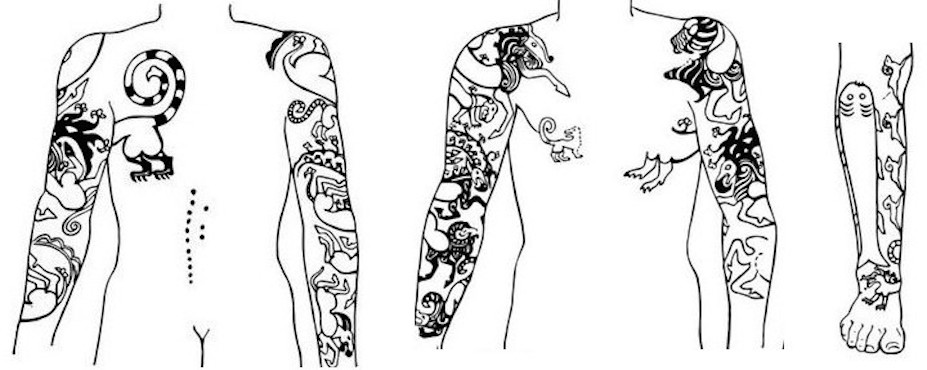Museum of the Origins of Man
POST-PALEOLITHIC ZOOMORPHIC, ANTHROPOMORPHIC AND GEOMETRIC TATTOOS TO EMBELLISH THE HUMAN BODY
 Fig. F59) Animal figure tattoos on the human body.
Fig. F59) Animal figure tattoos on the human body.
Drawing from an archaeologist's reconstruction.
From the grave of a Shiite chief; the ice that covered it preserved the skin of the mummified corpse with tattoos made with colored inks and representing a deer and a stylized ram on the right arm, two griffons on the chest and on the right leg a fish with other animals and decorative drawings.
The style of the tattoos has a component of Chinese art.
Among the Shiites, tattoos were symbols of the person's nobility.
Dating: about 2500 years.
Origin: Pazyryk (Altai Mountains), Southern Siberia.
Civilization of the Shiites.
 Fig. F60)Men with body completely covered with tattoos.
Fig. F60)Men with body completely covered with tattoos.
Origin: Hawaii Islands.
Etching of an European, 1841.
Tattooing in many peoples was a decoration for the beauty of the body. It was a tradition and a fashion; today, in Hawaii, it is in minor vogue. Instead, since some years it has spread as a fashion in Europe. Many young people get tattooed on every part of their bodies, even on shaved heads. Black or colored, tattoos can have the most varied subjects: from dragons to the name of a loved one.
NEXT
Index
HOME PAGE
Copyright©1999-2020 by Museum of the Origins of Man, all rights reserved.


